Also read: Bullet point version of this article
With the announcement of Speedlite 600EX-RT, Canon has significantly raised the bar in the world of hot-shoe flashes. The non-radio version, Speedlite 600EX, has also been released in a number of countries (at this point, it looks like 600EX will not be available in the U.S.). The goal of this article is to compare the new Canon flagship flash to the former one, Speedlite 580EX II. The comparison is based on the information available at the moment of this writing.
Please note, the new radio-based wireless system delivers much more than just an extended triggering range, including radio ID, slave feedback, and more, but it is the subject of a separate article (please refer to Canon Speedlite 600EX-RT vs. 600EX: more than just an extended range). In this review, we set the radio functions aside and focused on other improvements to see what else Canon has done to bring its high-end flashgun to the next level.
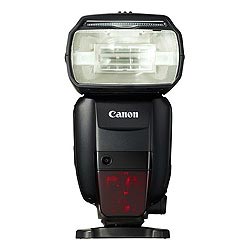 |
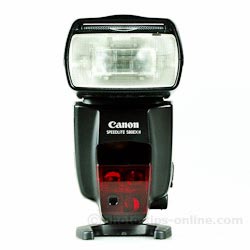 |
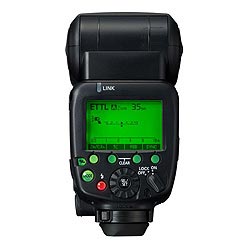 |
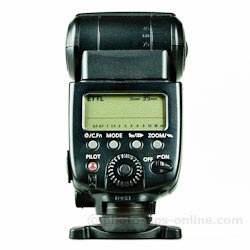 |
Canon Speedlite 600EX provides a much better interface than any of the previous Canon flash units. It is the first Canon flash to feature a dot-matrix LCD screen instead of a segment-based one. The new screen is the foundation of many interface improvements found on the 600EX flash.
The LCD is about 30% larger. The backlight color can be set to either green or orange, which is not only a matter of personal preference, but it can also be used to identify your flashes (you could make group A green and group B orange, for example). The LCD backlight also turns red when the unit reaches high internal temperatures due to rapid firing.
The menu system has been fully re-worked. It is easier to read and understand (especially the more complex wireless menus). There is no more remembering or looking up the magic numbers of the Custom Functions. Granted, with the latter cameras, it was possible to change custom functions using in-camera menus, but trying to do it on the 580EX II flash itself was a real mind game. Both Speedlite 600EX and 600EX-RT are more intuitive to operate.
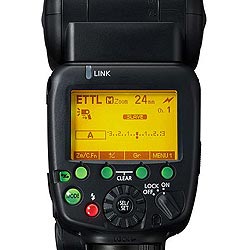 |
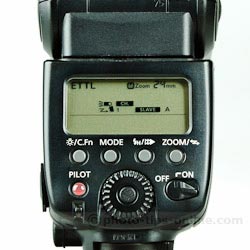 |
One of the things many professional photographers have been complaining to Canon about is the switching between master, slave, and regular mode. With Speedlite 580EX II, you had to press and hold the Zoom button for two seconds to go in and out of wireless mode. This approach is not well-suited for dynamic environments like weddings, for example. Canon Speedlite 600EX addresses the issue with a dedicated wireless button. This seemingly small change is a great improvement that will be appreciated by many professional photographers.
One of the minor issues we always had with the 580EX II flash is the fact that the controls are not backlit. Even after using the flash for years, we still find it uncomfortable not being able to see the buttons under very dim lighting conditions. Well, with the new Speedlite 600EX, it is not a problem anymore. All buttons are backlit, except for the select button on the dial, which we believe is perfectly fine.
Another improvement of 600EX is the ability to lock flash controls. Depending on your workflow and applications, this feature can be quite valuable. With 580EX II, there is no way to prevent settings from changing when you accidentally touch the select dial or buttons.
Even though Speedlite 580EX II is already a rock solid unit, Canon managed to improve things like flash head durability and weather resistance. All buttons and moving parts are sealed even better for exceptional performance in harsh conditions.
During the past years, photographers were reporting occasional problems with the hot shoe connection of Speedlite 580EX II. While this problem did not seem to be a major one and could be overcome with some tricks, it was common enough, so Canon made a note of it and completely redesigned the hot shoe contacts on the new 600EX Speedlite series.
The 580EX II flash head is capable of zooming from 24mm to 105mm. The new head design extends the range of Speedlite 600EX on both ends: 20mm to 200mm. (With the built-in wide angle panel, both flashes cover 14mm angle.)
Canon specifies Guide Numbers for their flashes at the maximum flash zoom setting. Therefore, 600EX is listed with the Guide Number of 60, whereas 580EX II is at 58. This may lead users to believe that the new flash is more powerful. In reality, if you compare the Guide Numbers at identical zoom positions, the power output of both flashes is very similar, if not identical. So, there is no extra kick to be expected from the new Speedlite 600EX or 600EX-RT.
Among other improvements found on Speedlite 600EX are compatibility with the latest 61-point auto-focus (of Canon EOS-1D X and EOS 5D Mark III), new custom and personal functions for improved customization, and included filter holder for color correction and artistic effects. All these useful changes make the 600EX flash even more appealing.
Even without the revolutionary built-in radio communication system, Canon Speedlite 600EX and 600EX-RT are very impressive advancements. The more robust construction for better durability and reliability, extended zoom range for more flexibility, and support of the new 61-point AF are worthy improvements. What we like the most, however, is the way we can now interact with the flash. Thanks to the new large dot-matrix LCD, backlit buttons, dedicated wireless mode switch, and fully overhauled menus, Canon Speedlite 600EX is what many Canon photographers around the globe have been waiting for.
Now, is it worth upgrading from Speedlite 580EX II to Speedlite 600EX? It all depends on your personal situation. How many of 580EX II do you already have? How much can you sell them for? Do you do the kind of photography where you can benefit from extended zoom range or better dust and water protection? Is the interface of 580EX II a real issue for what you do? Are you going to get one of the latest camera bodies like Canon 5D Mark III? As for us, upgrading from 580EX II to 600EX does not look like something that everyone should jump to, but if we would need to get additional flashes, Speedlite 600EX is our choice, assuming that the price difference is reasonable.